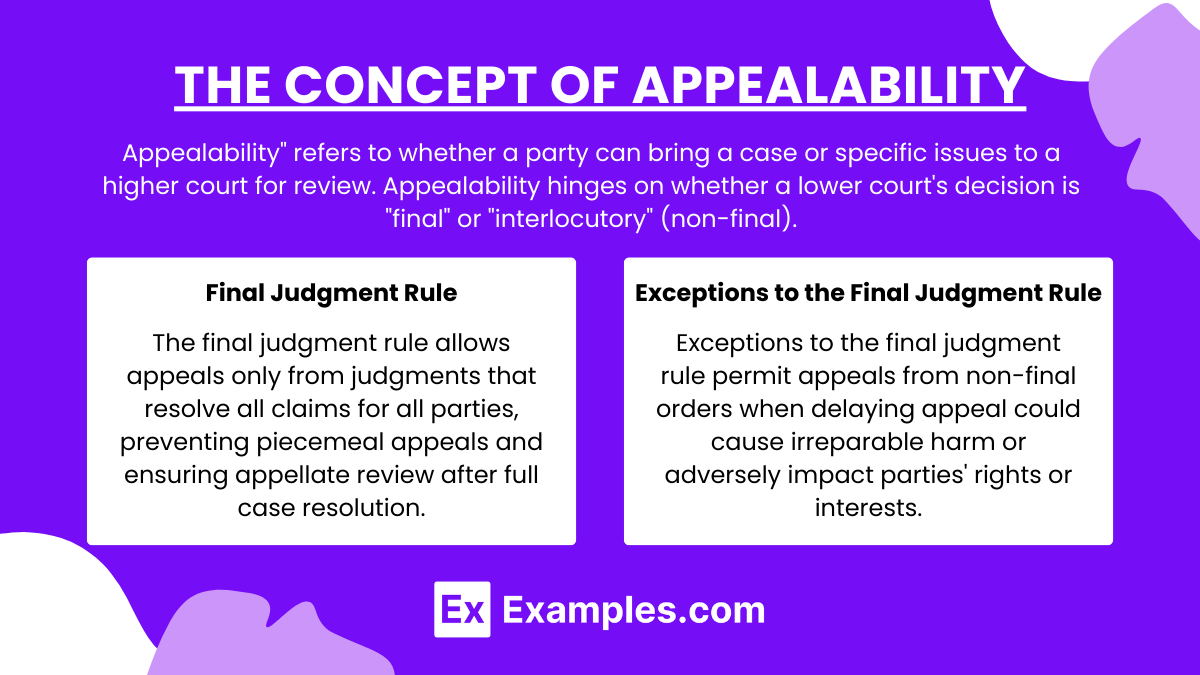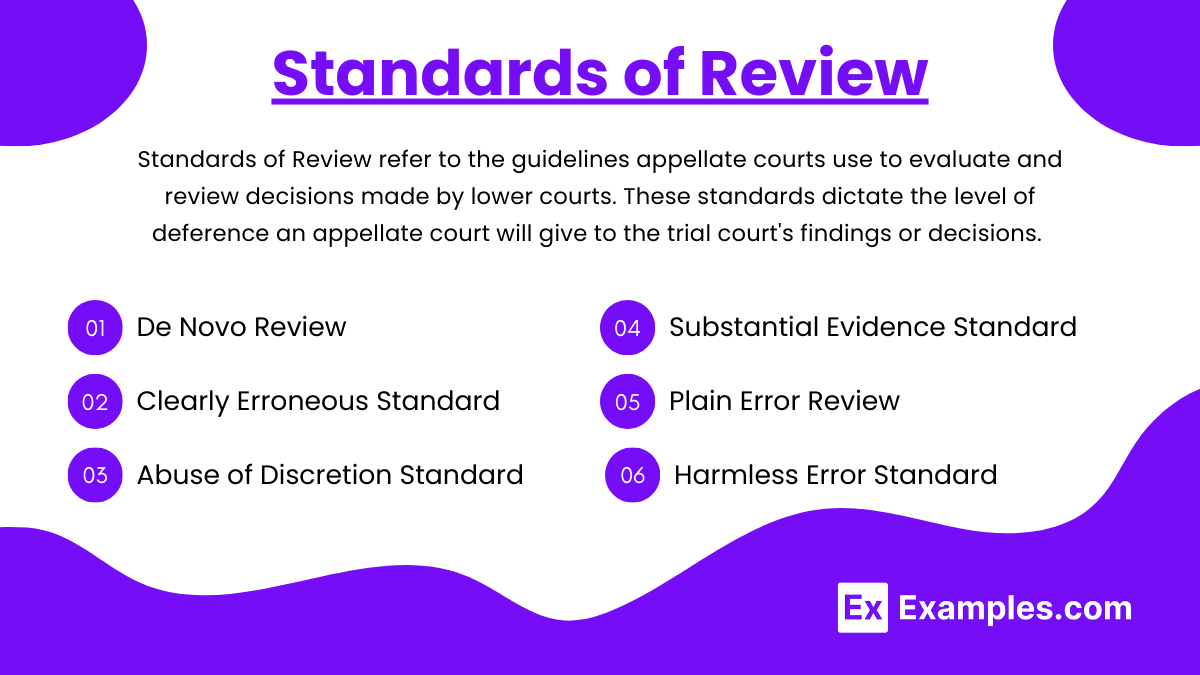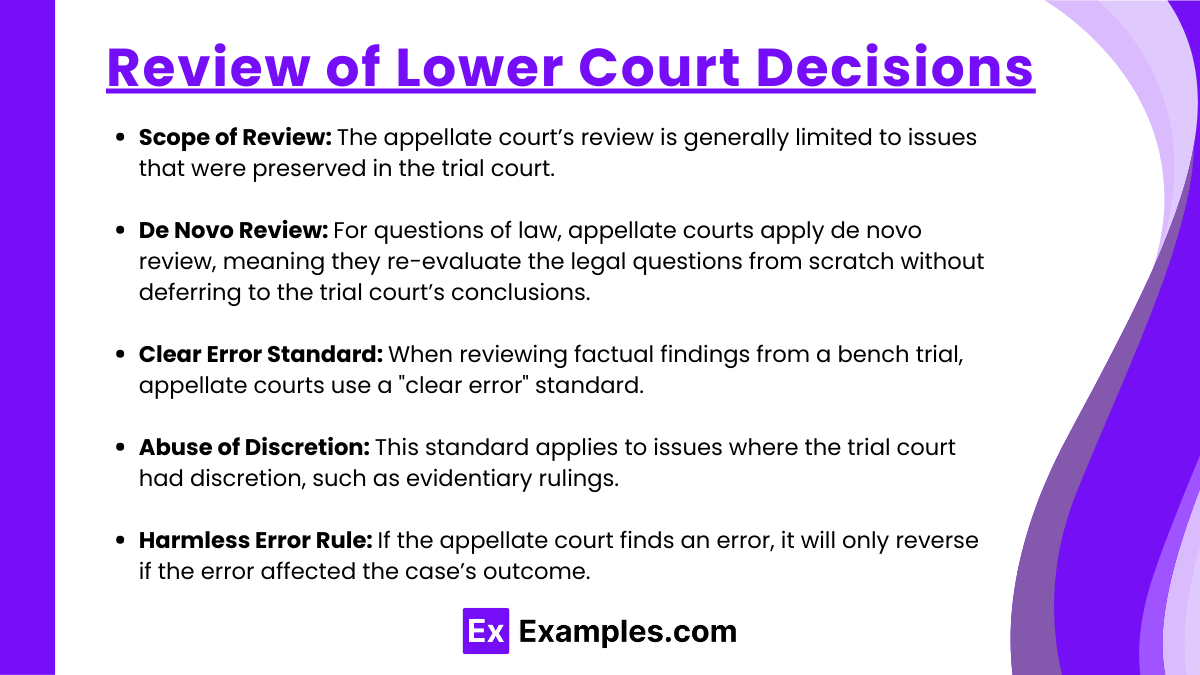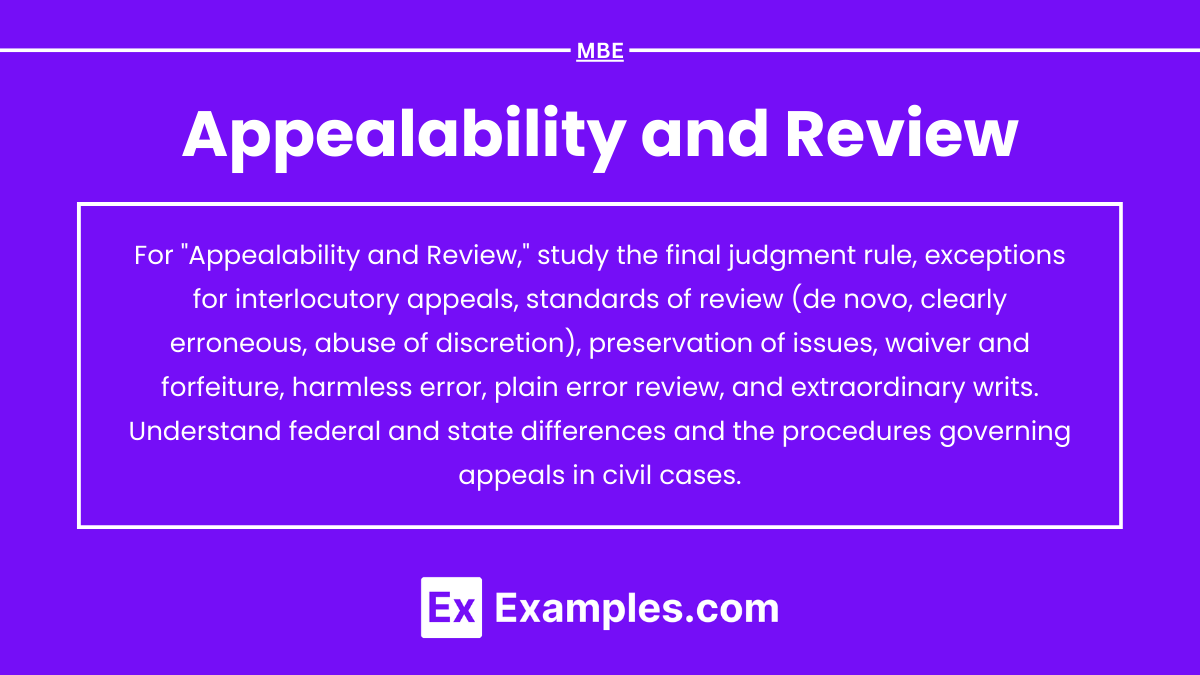"Appealability and Review" in civil procedure examines the principles and limitations surrounding appellate court jurisdiction over trial court decisions. This area focuses on determining which judgments and orders are eligible for appeal, the timing of appeals, and the standards of review applied by appellate courts. The final judgment rule generally limits appeals to completed cases, while certain interlocutory orders may be reviewed if they meet specific criteria. Understanding appealability and review is essential for recognizing when and how litigants can challenge lower court rulings within the judicial process.
Learning Objectives
In studying "Civil Procedure: Appealability and Review" for the MBE, you should learn to understand the criteria for appealable orders and the distinctions between final and interlocutory appeals. Analyze the purpose and application of doctrines like the Collateral Order Doctrine and Rule 54(b) certification, which allow for appeals in non-final judgments. Evaluate different standards of review—such as de novo, clearly erroneous, and abuse of discretion—and how they guide appellate courts in examining lower court decisions. Additionally, explore the concepts of waiver, forfeiture, and plain error, and apply your understanding to interpreting case scenarios in MBE practice questions.
1. The Concept of Appealability

"Appealability" refers to whether a party can bring a case or specific issues to a higher court for review. Appealability hinges on whether a lower court's decision is "final" or "interlocutory" (non-final).
Final Judgment Rule: The final judgment rule states that appeals are typically allowed only from final judgments. A final judgment is one that resolves all claims for all parties, effectively concluding the litigation at the trial court level. This rule helps maintain judicial efficiency by avoiding fragmented, piecemeal appeals and reserving appellate review for cases that have been fully resolved.
Exceptions to the Final Judgment Rule: Despite the rule, there are specific exceptions allowing appeals from certain non-final orders. These exceptions help address situations where waiting for a final judgment might result in irreparable harm or undermine the rights of the parties involved.
Interlocutory Appeals: Certain non-final decisions may be appealed before the case is completely resolved. These are allowed only under specific conditions, typically in cases where a delay would cause irreparable harm. Examples include:
Collateral Order Doctrine: This narrow exception allows appeal of orders that are separate from the main issue of the case, are conclusively decided, and would be effectively unreviewable later.
Certification of Immediate Appeal: A trial court may certify an issue for immediate appeal if it involves a "controlling question of law" with substantial grounds for difference of opinion, and an immediate appeal could materially advance the litigation’s conclusion.
Statutory Exceptions: Certain statutes provide exceptions to the final judgment rule, allowing appeals in cases like class action certifications.
2. Standards of Review

Standards of Review refer to the guidelines appellate courts use to evaluate and review decisions made by lower courts. These standards dictate the level of deference an appellate court will give to the trial court's findings or decisions. Each standard applies to different types of issues, and they vary in strictness based on the nature of the question under review—whether it's a question of law, fact, or a discretionary decision. Common standards include:
1. De Novo Review
De novo review is applied to questions of law, meaning the appellate court examines legal issues without any deference to the lower court’s conclusions. In this standard, the appellate court assesses the legal question as if it were deciding it for the first time, independently interpreting the law. De novo review is commonly used in cases involving the interpretation of statutes, contracts, or constitutional provisions, where the primary issue is a matter of legal understanding rather than factual determination.
2. Clearly Erroneous Standard
The clearly erroneous standard is a more deferential standard than de novo, used specifically for reviewing factual findings in cases tried without a jury (bench trials). Under this standard, the appellate court will only overturn the trial court’s factual findings if it has a “definite and firm conviction” that a mistake was made. This means the appellate court respects the trial court's role in assessing witness credibility and evidence but will intervene if a factual conclusion appears obviously wrong or unsupported by the evidence.
3. Abuse of Discretion Standard
The abuse of discretion standard is highly deferential and focuses on whether the lower court acted reasonably within its discretionary authority. This standard is applied to discretionary decisions, such as evidentiary rulings, sentencing, and procedural matters, where trial judges have flexibility in making judgments. An appellate court under this standard will only overturn a decision if it is arbitrary, unreasonable, or irrational, indicating that the trial court overstepped the bounds of reasonable judgment.
4. Substantial Evidence Standard
The substantial evidence standard also defers to the lower court, especially in cases involving jury trials or administrative appeals, where factual findings are based on the evidence presented. Under this standard, the appellate court checks whether sufficient evidence supports the decision. The goal is to ensure that there is a reasonable foundation for the factual conclusions reached at trial. If reasonable minds could differ on the issue, the decision is upheld even if another conclusion could also be reached.
5. Plain Error Review
Plain error review applies to unpreserved errors—issues not raised at trial that are so significant they affect the fundamental fairness of the trial. This standard allows appellate courts to address errors that are clear or obvious, affecting the integrity of the proceedings. To correct an error under this standard, the appellate court must conclude that the error was serious, impacted the substantial rights of the parties, and likely influenced the outcome. This standard is commonly applied in criminal cases where a fundamental right may have been overlooked, even without objection from the defense during trial.
6. Harmless Error Standard
The harmless error standard acknowledges that an error may have occurred but examines whether it actually affected the outcome. This standard is applied when the appellate court finds a mistake in the trial proceedings but determines that it didn’t have a material impact on the final decision. The appellate court will uphold the trial court’s ruling if the error is deemed harmless, meaning it was minor and likely did not influence the verdict. This standard ensures that minor procedural or evidentiary errors do not result in retrials unless they truly impacted the fairness of the process.
3. Review of Lower Court Decisions

Scope of Review: The appellate court’s review is generally limited to issues that were preserved in the trial court. Issues not raised in the lower court are typically waived and cannot be argued on appeal unless they involve "plain error" or issues of fundamental fairness.
De Novo Review: For questions of law, appellate courts apply de novo review, meaning they re-evaluate the legal questions from scratch without deferring to the trial court’s conclusions. Examples include interpretations of statutes or legal standards.
Clear Error Standard: When reviewing factual findings from a bench trial, appellate courts use a "clear error" standard. This standard is highly deferential to the trial court; the appellate court will not overturn findings unless they are clearly erroneous or not supported by evidence.
Abuse of Discretion: This standard applies to issues where the trial court had discretion, such as evidentiary rulings, sanctioning decisions, or rulings on procedural matters like granting continuances. An appellate court will only reverse if the trial court’s decision was unreasonable or outside the bounds of acceptable choices.
Harmless Error Rule: If the appellate court finds an error, it will only reverse if the error affected the case’s outcome. Minor errors that did not impact the final decision are deemed "harmless," and the lower court’s ruling will stand.
Examples
Example 1: Final Judgment Rule and the Collateral Order Doctrine
A plaintiff sues a defendant for breach of contract. The trial court grants summary judgment on one of the plaintiff’s claims but leaves other claims pending. The plaintiff seeks to immediately appeal this partial summary judgment. Under the final judgment rule, this partial decision is generally not immediately appealable since it does not conclude the entire case. However, if the order affected rights that are separate from the main claims (such as a privilege issue), the plaintiff might argue that the collateral order doctrine applies, allowing an immediate appeal.
Example 2: Interlocutory Appeal of Injunctive Relief
A company sues its competitor, seeking a preliminary injunction to prevent the competitor from using allegedly stolen trade secrets. The trial court denies the preliminary injunction, and the company immediately appeals this decision. Because the denial of an injunction qualifies for interlocutory appeal, the appellate court can review the trial court’s decision on this issue before the case is fully resolved. The appellate court would likely apply an "abuse of discretion" standard in reviewing whether the trial court appropriately denied the preliminary injunction.
Example 3: De Novo Review of Legal Questions
During a civil trial, the court interprets a state statute in a way that heavily impacts the plaintiff’s claims, leading to a judgment in favor of the defendant. The plaintiff appeals, arguing that the trial court misinterpreted the statute. On appeal, the court will review the trial court’s legal interpretation de novo, meaning it will not defer to the lower court’s interpretation. The appellate court will independently analyze the statute's meaning and apply its own understanding to determine whether the trial court’s interpretation was correct.
Example 4: Appeal Based on Harmless Error
In a personal injury case, the trial judge allows a piece of evidence that the defendant objected to as hearsay. After the trial, the jury finds in favor of the plaintiff, and the defendant appeals, arguing that the admission of the hearsay evidence was improper. The appellate court acknowledges that the trial court erred in admitting the evidence, but it concludes that the error was harmless because there was ample other evidence supporting the plaintiff's claims. Since the error likely didn’t affect the outcome, the appellate court affirms the lower court’s judgment.
Example 5: Plain Error Review in the Absence of Objection
In a breach of contract case, the trial court gives a jury instruction that mistakenly defines a legal term in a way that could harm the defendant’s case. However, the defendant did not object to this instruction at trial. On appeal, the defendant argues that the instruction was incorrect. The appellate court may apply "plain error" review since the issue wasn’t preserved at trial. Under this standard, the court will determine whether the error was obvious and affected the fairness or integrity of the proceedings, and it may reverse if it finds that the error meets these criteria.
Practice Questions
Question 1
A federal district court issues a preliminary injunction against a company, prohibiting it from certain business practices until the final resolution of the case. The company disagrees with the injunction and wants to appeal immediately. Under the Federal Rules of Civil Procedure, is the company allowed to appeal the preliminary injunction before the case concludes?
A. Yes, because interlocutory orders related to injunctions are immediately appealable.
B. No, because only final judgments can be appealed.
C. Yes, because any order that affects the company’s business practices is automatically appealable.
D. No, because preliminary injunctions are never appealable until the final judgment.
Answer: A
Explanation: Under the Federal Rules of Civil Procedure, interlocutory orders related to injunctions (including preliminary injunctions) are immediately appealable. This is an exception to the final judgment rule, which usually restricts appeals to final judgments that resolve all issues between the parties. The logic behind allowing interlocutory appeals for injunctions is that injunctions can have an immediate and significant impact on the parties' rights and obligations, so delaying an appeal until the final resolution of the case could result in irreparable harm. Therefore, the company has the right to appeal the preliminary injunction immediately.
Question 2
A plaintiff sues a defendant in federal court for breach of contract, and the court grants summary judgment in favor of the defendant on two out of three claims, leaving one claim pending. The plaintiff wishes to appeal the summary judgment. Which of the following is true regarding the plaintiff’s right to appeal at this stage?
A. The plaintiff can appeal the summary judgment immediately because summary judgment is appealable.
B. The plaintiff can appeal if the district court certifies the judgment as final under Rule 54(b).
C. The plaintiff can appeal immediately because the two claims were resolved, even if one claim remains.
D. The plaintiff cannot appeal until the remaining claim is resolved, regardless of certification.
Answer: B
Explanation: Under Rule 54(b) of the Federal Rules of Civil Procedure, when multiple claims or parties are involved in a case, the court may direct entry of a final judgment on some, but not all, claims if it finds "no just reason for delay." This certification allows the resolved claims to be appealed immediately, even though other claims remain pending. If the district court does not certify the judgment under Rule 54(b), then the plaintiff must wait until all claims are resolved before appealing. Here, the plaintiff would need the district court to certify the judgment on the two resolved claims to appeal them now. Otherwise, the appeal must wait until the last claim is also resolved.
Question 3
A federal district court judge makes an evidentiary ruling during a trial that the defendant believes is erroneous. The defendant appeals the ruling immediately before the trial concludes. Which of the following best describes the appellate court’s response to this appeal?
A. The appellate court will review the evidentiary ruling de novo because it involves a legal question.
B. The appellate court will likely dismiss the appeal because evidentiary rulings are generally not immediately appealable.
C. The appellate court will review the evidentiary ruling for abuse of discretion, as evidentiary decisions are immediately appealable.
D. The appellate court will likely accept the appeal because interlocutory appeals for evidentiary rulings are allowed.
Answer: B
Explanation: Evidentiary rulings made during a trial are generally not immediately appealable because they are considered interlocutory orders, not final judgments. The final judgment rule usually restricts appeals to final orders that conclude all issues in a case. There are limited exceptions to this rule, such as for injunctions or under the collateral order doctrine, but evidentiary rulings do not typically fall under these exceptions. The appellate court would likely dismiss the appeal, as it must wait for a final judgment before reviewing trial-related evidentiary rulings. This rule ensures judicial efficiency and prevents piecemeal appeals, which could delay the proceedings unnecessarily.


